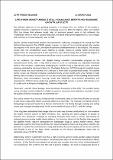March 2011 Basic Needs and Nutrition Basket: Life in High Density Areas is Still a Challenge Despite High Economic Growth, Says JCTR

View/
Date
2011-03-12Author
Jesuit Centre for Theological Reflection
Type
StatementLanguage
enItem Usage Stats
76
views
views
17
downloads
downloads
Abstract
So far, evidence has shown that despite having recorded commendable progress on the macroeconomic front, there is very little to show in as far as translating into improved household welfare. This situation is particularly challenging for families living in high density areas. Anecdotal evidence collected by the Jesuit Centre for Theological Reflection (JCTR) through its’ satellite homes research show that many families find it difficult to meet their household food needs. The satellite homes survey are informal interviews conducted every second month with some families in high density areas of Lusaka. It focuses on various socio economics aspects of life including family health; Education; food consumption; housing, water and electricity; socio-political perceptions and
employment. JCTR has been conducting qualitative household surveys in various high density areas of Lusaka such as Kanyama, Kalingalinga, Chainda and Ngombe.
Description
The ultimate objective of any growing economy is to ensure that the welfare of the people is uplifted. However, experience of many developing countries after the eighties (80s) and nineties (90s) has shown that whereas target rates of economic growth were in fact achieved, the ‘trickledown’ effect in form of poverty reduction, increased employment opportunities, rise in wages and reduction in income inequality was not felt.